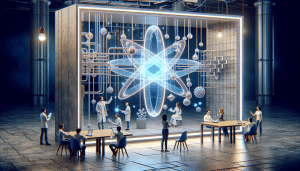The Surprising Ways Artificial Intelligence Impacts You
Aiden Foster September 4, 2025
Artificial intelligence is everywhere, influencing daily decisions and the way information travels. Unlock the fascinating world of AI technology, its innovative applications in science, and how it shapes everything from personalized recommendations to healthcare. This guide clarifies what artificial intelligence really is and explores its unexpected role in ordinary life.
Understanding the Basics of Artificial Intelligence
Artificial intelligence (AI) has become more than just a technical buzzword. It refers to the ability of computers or machines to perform tasks that usually require human intelligence, such as learning, reasoning, and problem-solving. Everyday phrases like ‘machine learning,’ ‘natural language processing,’ and ‘neural networks’ all fit under the vast AI umbrella. These digital brains process massive amounts of data far faster than humans ever could, discovering patterns, making predictions, and generating insights. Crucially, AI isn’t just about robots or automation—it’s a foundation for everything from digital assistants in your pocket to recommendations on streaming platforms.
What sets AI apart, especially in science and technology, is its learning capability. Instead of following simple, pre-set instructions, advanced algorithms adapt and improve over time based on new information. This learning happens via access to datasets and feedback loops, making artificial intelligence more accurate and versatile with continued use. That’s why AI-driven systems evolve, delivering results that feel increasingly personalized or human-like. From analyzing massive genomic datasets for medical research to filtering images on social media, AI quietly powers countless innovations.
With so many conversations about technology trends, people often wonder where AI stops and traditional computing begins. The distinction is in flexibility and adaptability. AI excels at handling uncertain, ambiguous situations—recognizing speech despite accents, translating text across languages, and even identifying objects in blurry photos. This flexibility fuels AI’s integration not only in entertainment, but also in sectors like healthcare, transportation, and energy. The underlying principle is simple: AI uses data to learn and to optimize outcomes, making it a transformative technology with wide-reaching impacts.
Artificial Intelligence in Everyday Life
Most individuals encounter artificial intelligence without realizing it. When a phone understands voice commands or suggests the next word as a message is typed, that’s AI in action. Recommendation systems on platforms like Netflix and Spotify use machine learning models, analyzing viewing or listening habits to deliver highly personalized suggestions. This isn’t magic but a sophisticated system comparing millions of user interactions and seeking out patterns. That’s why two people rarely see the same home screen on these platforms—AI remembers preferences and tries to anticipate interests.
Online shopping benefits from artificial intelligence, too. Predictive analytics powers dynamic pricing and targeted advertisements, adjusting what a user sees based on browsing behavior. These AI algorithms analyze factors like search queries, clicked items, and even geographic location. The result is a shopping experience that often feels strikingly intuitive. In the background, machine learning models are not just pushing products—they help streamline supply chains, forecast demand, and optimize delivery logistics for faster, more efficient service.
Smart assistants like Siri, Alexa, and Google Assistant employ natural language processing and voice recognition algorithms to respond to queries, set reminders, and control smart devices. This hands-free convenience is powered by thousands of hours of language learning, contextual understanding, and voice parsing—all orchestrated by AI. As these platforms mature, their responses feel less scripted and more conversational, closing the gap between digital and human interaction in unexpected ways.
Breakthroughs in Science and Healthcare Through AI
One of the most exciting, high-potential uses for artificial intelligence is in science and medicine. In medical diagnostics, AI-driven systems already help identify diseases on medical images—such as X-rays or MRIs—with accuracy on par with experienced radiologists. Algorithms can detect minute differences on scans that might escape even trained eyes, improving the speed and precision of early diagnosis. This application carries huge implications for conditions like cancer, where early intervention saves lives (Source: https://www.cancer.gov/about-cancer/treatment/research/artificial-intelligence).
Beyond diagnostics, AI assists in drug discovery, analyzing millions of chemical compounds and predicting which ones are most likely to treat a particular disease. Traditionally, this process could take years, but AI-driven models compress timelines and open new treatment avenues. Researchers also use AI to find correlations among genetics, environment, and health outcomes—shedding light on complex diseases and paving the way for personalized medicine. The capacity to sift through huge healthcare databases enables scientists to uncover new risk factors, identify medication interactions, and optimize therapeutic protocols.
Another major breakthrough lies in tracking disease outbreaks and predicting the spread of viruses. Public health agencies use advanced machine learning to process data from travel records, social media, and clinical reports. This approach provides early warnings and helps allocate resources more efficiently during pandemics or seasonal flu waves (Source: https://www.cdc.gov/amd/whatis/index.html). Artificial intelligence becomes a real-time surveillance tool, helping cities and organizations stay agile in the face of health emergencies.
Artificial Intelligence and Data Privacy Concerns
As artificial intelligence systems become more sophisticated, concerns over data privacy and ethical use grow. AI’s ability to process vast amounts of sensitive personal data—like search history, medical records, or financial transactions—raises questions about user consent and data ownership. Without rigorous privacy frameworks, there’s a risk of information misuse or unintentional bias. For instance, algorithms trained on incomplete or biased data may inadvertently reinforce stereotypes or disadvantage certain groups.
In many countries, regulations are emerging to address data protection in the era of artificial intelligence. Europe’s General Data Protection Regulation (GDPR) sets comprehensive guidelines, specifying how personal data collected by AI should be handled, stored, and erased. Transparency also matters. It’s important for organizations using AI to explain how decisions are made, especially in contexts like lending, hiring, or healthcare. Ongoing efforts by government agencies and advocacy groups aim to ensure AI platforms respect fundamental rights and operate fairly (Source: https://gdpr-info.eu/).
Users, too, play a role in protecting their data. Being aware of digital footprints, using secure passwords, and managing permissions for apps and devices is increasingly essential. Tech companies are investing in privacy-preserving machine learning techniques—like differential privacy and federated learning—to minimize risks. These technologies allow AI systems to learn from trends without directly accessing individual user data. As AI becomes more embedded in daily life, striking a balance between efficiency and privacy stays at the forefront of discussion.
AI’s Role in Shaping the Future of Work and Education
Artificial intelligence continues to transform the landscape of work by automating repetitive tasks and generating insights that enhance productivity. In offices, AI-powered systems route emails, prioritize helpdesk tickets, and even schedule meetings. In manufacturing and logistics, robots and smart machinery leverage deep learning models to handle goods, maintain inventory, and minimize errors. This shift means workers are freed from routine labor to focus on creative or strategic roles that require human judgment.
Education is evolving as teachers and students leverage AI tools. Adaptive learning platforms, powered by sophisticated algorithms, adjust lesson difficulty based on each student’s progress. AI-based tutoring programs provide immediate feedback, helping identify gaps and suggest tailored practice. This personalizes education, allowing learners to move at their own pace and focus on building confidence in areas needing improvement. Schools and universities also use smart analytics to forecast student performance trends and ensure targeted support.
The workforce of tomorrow will likely require new skills rooted in both technology and creative thinking. Demand grows for roles involving data science, machine learning, and the ethical management of digital platforms. At the same time, emotional intelligence and collaboration remain vital, as machines cannot fully replace complex human relationships. As organizations and schools adapt, understanding AI’s possibilities—and its limits—prepares society for a productive, innovative future. Training and upskilling in AI-related fields offer numerous avenues for career growth (Source: https://www.onetcenter.org/dictionary/update2018.html).
Ethical Challenges and Opportunities in Artificial Intelligence
With great power comes great responsibility. The ethical challenges linked to AI are complex and multifaceted. One major discussion is algorithmic bias. When AI systems are trained on unrepresentative data, they may perpetuate existing inequalities—whether in hiring decisions, credit approvals, or criminal justice. Recognizing this, developers and regulators are prioritizing fairness, accountability, and transparency throughout the AI lifecycle.
Another ethical consideration is the potential for automation to displace existing jobs. Thoughtful policy and reskilling programs can help societies manage transitions smoothly. Conversely, AI opens up new opportunities, including roles in designing, managing, and auditing these intelligent systems. By investing in education and building a diverse AI workforce, organizations can minimize risk and maximize benefit. This proactive approach empowers more equitable, forward-looking innovations.
Ultimately, the future trajectory of artificial intelligence depends on collaborative effort by technologists, policymakers, and communities. Ethical AI guidelines by international organizations and industry groups aim to safeguard values such as human rights, inclusiveness, and sustainability (Source: https://ec.europa.eu/digital-strategy/our-policies/european-approach-artificial-intelligence_en). Thoughtful reflection, ongoing education, and commitment to shared principles form the backbone for responsible, positive AI development.
References
1. National Cancer Institute. (n.d.). Artificial Intelligence in Cancer Research. Retrieved from https://www.cancer.gov/about-cancer/treatment/research/artificial-intelligence
2. Centers for Disease Control and Prevention. (n.d.). Advanced Molecular Detection. Retrieved from https://www.cdc.gov/amd/whatis/index.html
3. European Commission. (n.d.). European Approach to Artificial Intelligence. Retrieved from https://ec.europa.eu/digital-strategy/our-policies/european-approach-artificial-intelligence_en
4. General Data Protection Regulation (GDPR). (n.d.). Key provisions. Retrieved from https://gdpr-info.eu/
5. U.S. Department of Labor. (n.d.). O*NET Resource Center. Retrieved from https://www.onetcenter.org/dictionary/update2018.html
6. Stanford University Human-Centered Artificial Intelligence. (n.d.). Artificial Intelligence Index Report. Retrieved from https://hai.stanford.edu/research/ai-index-report








